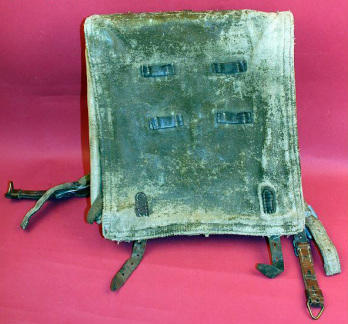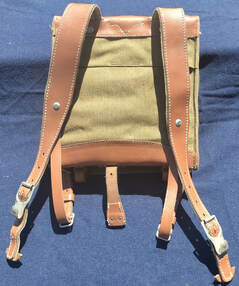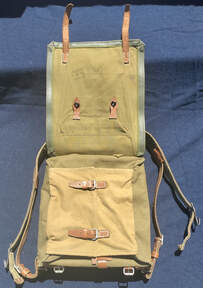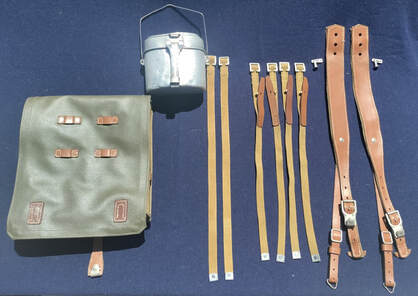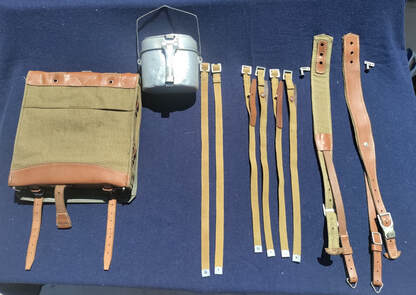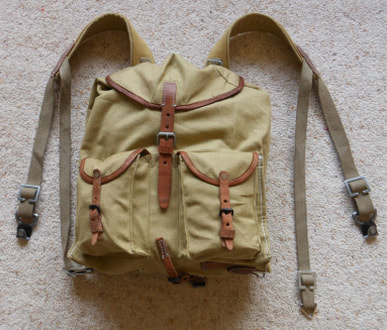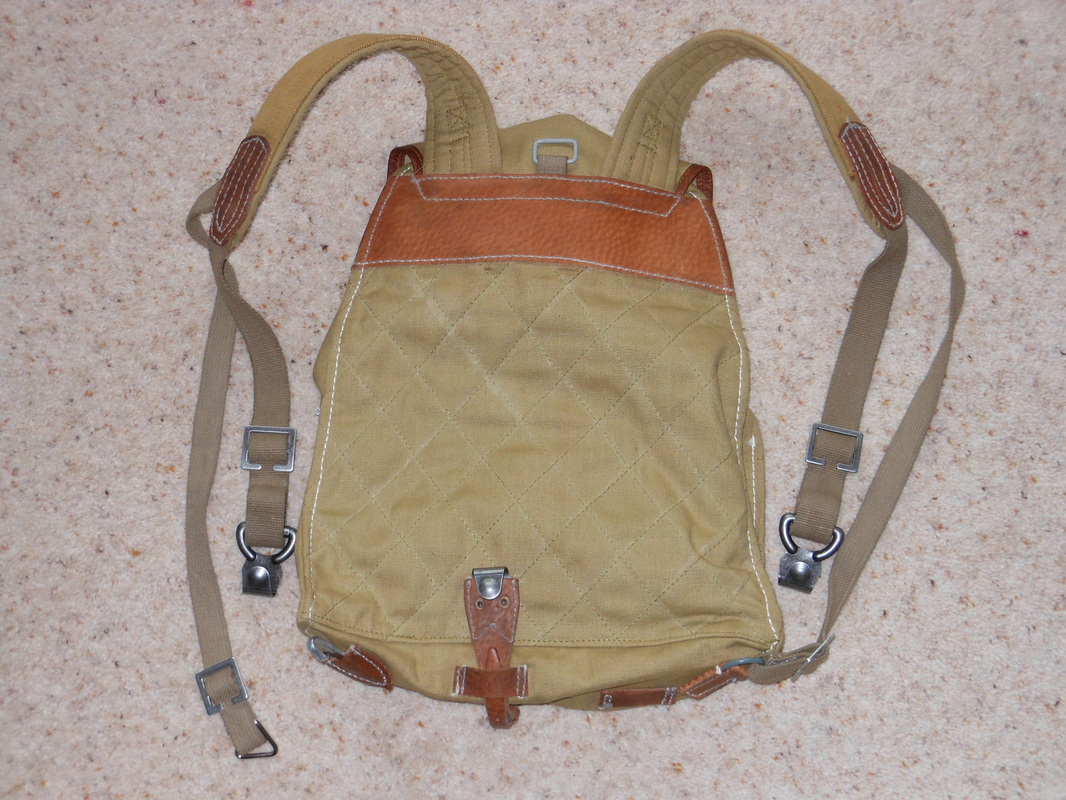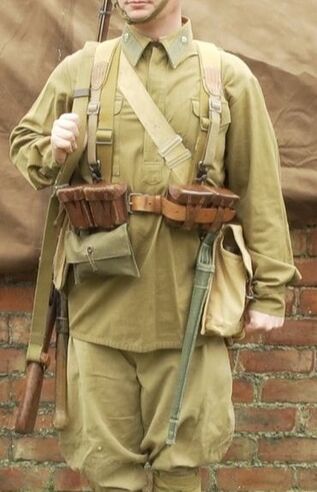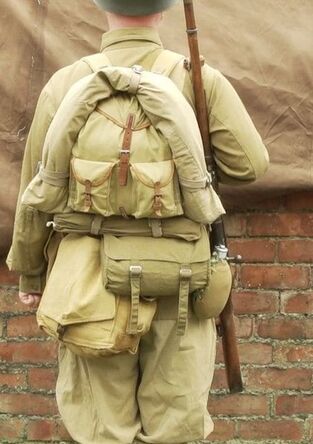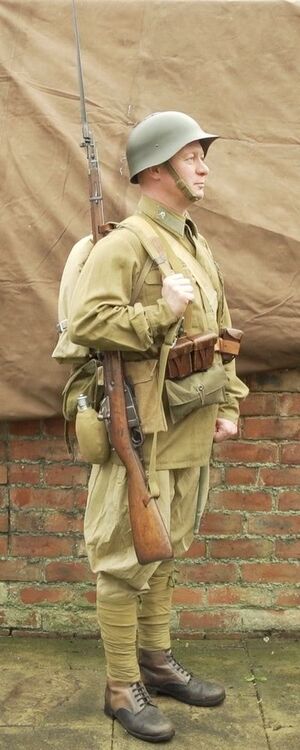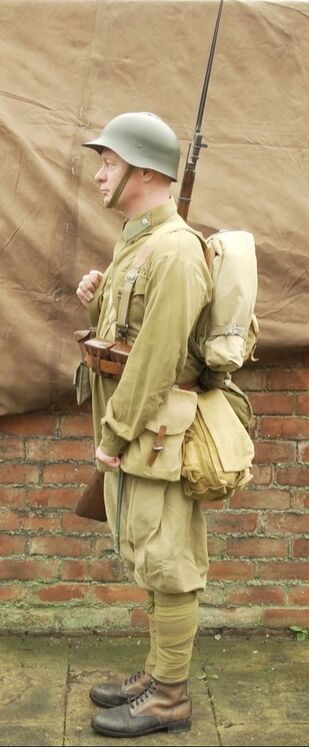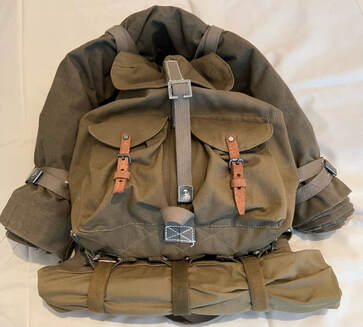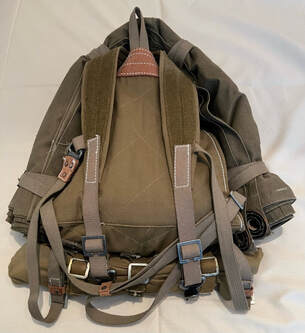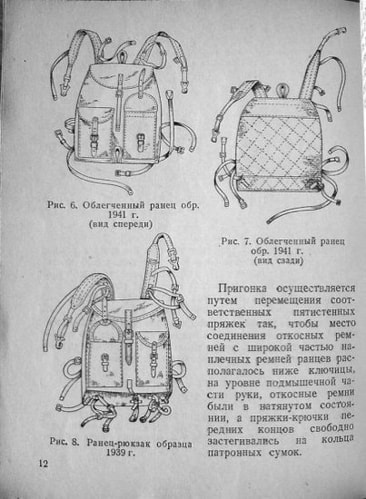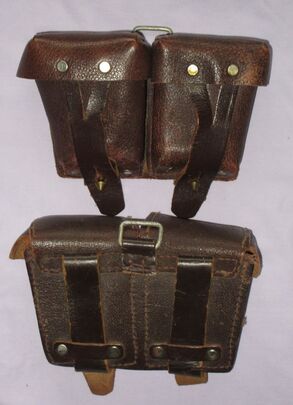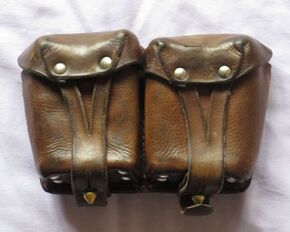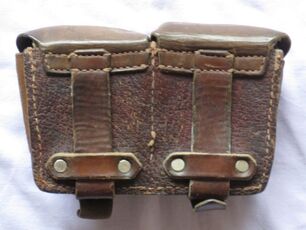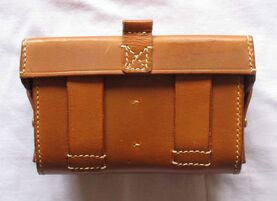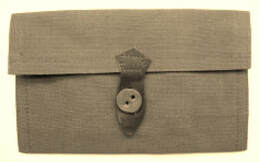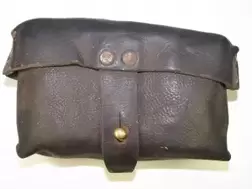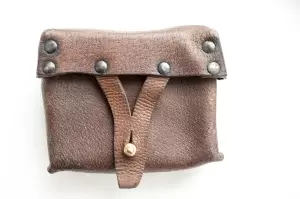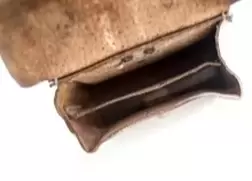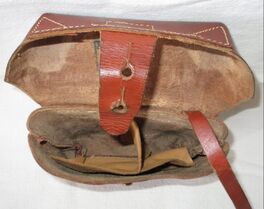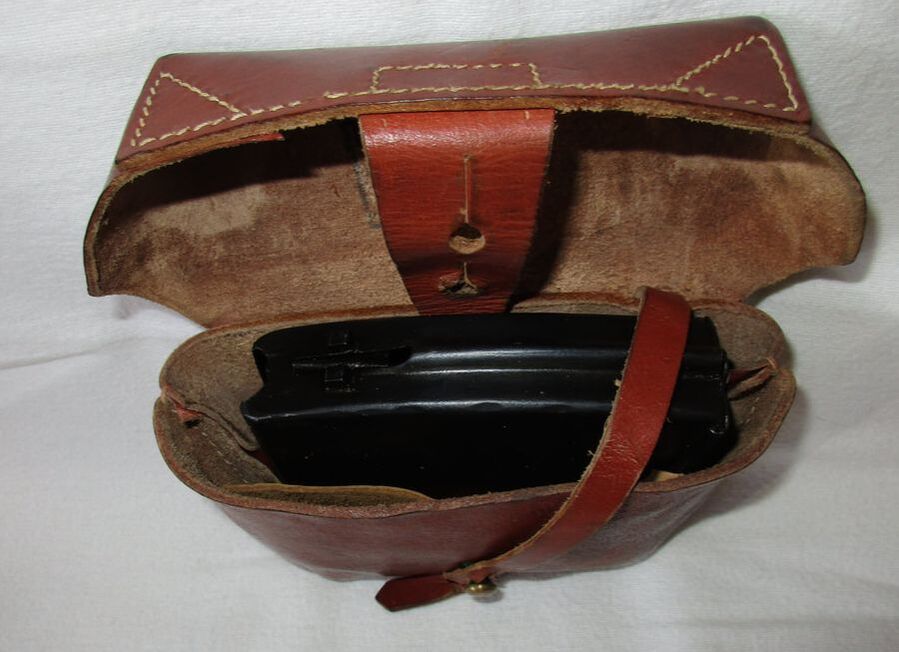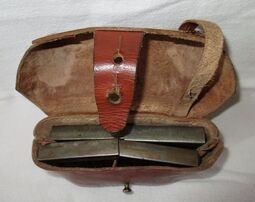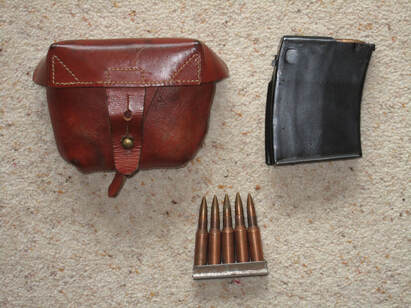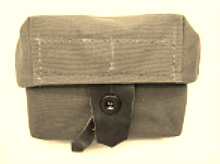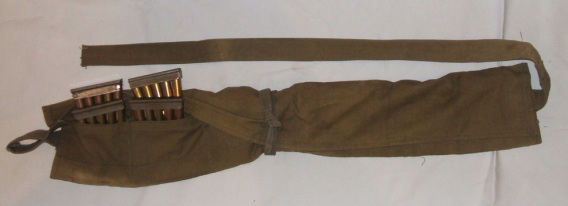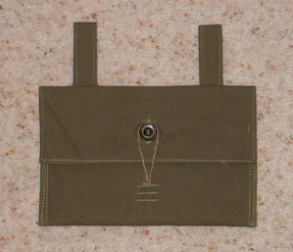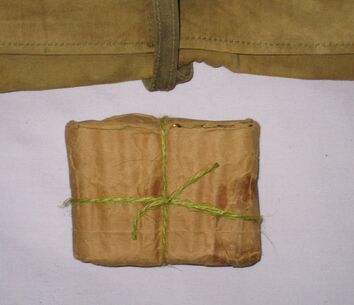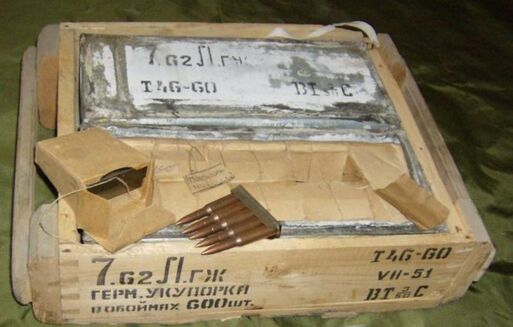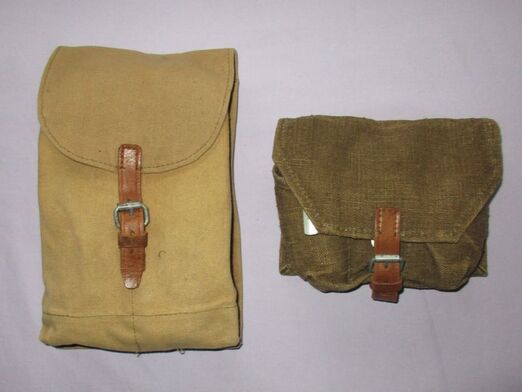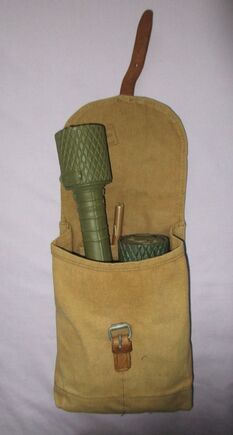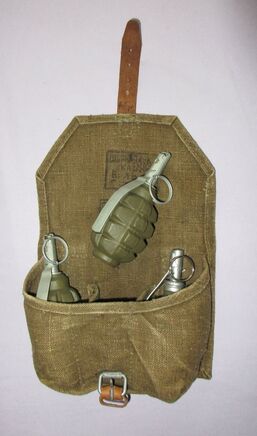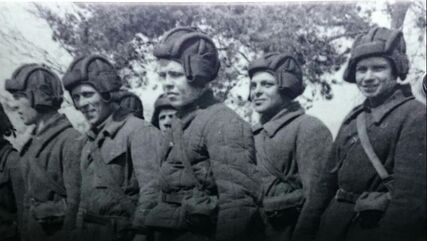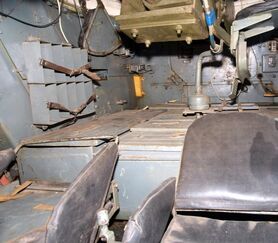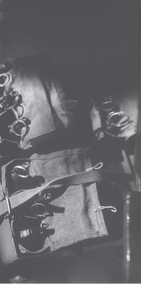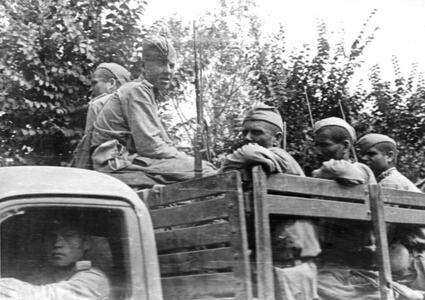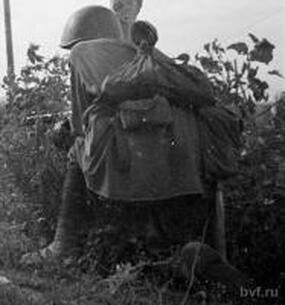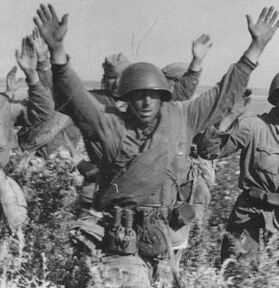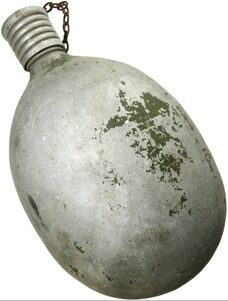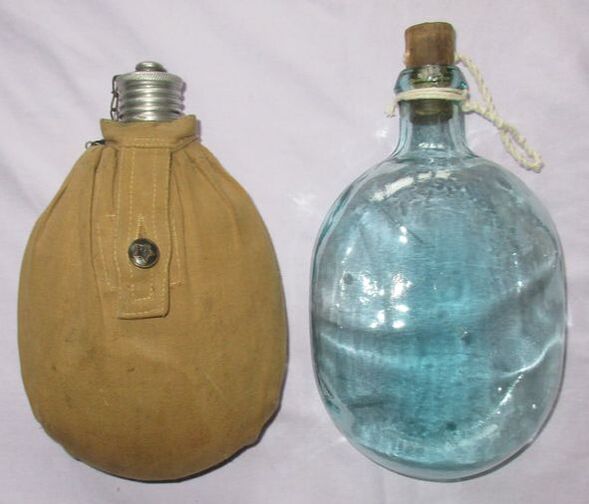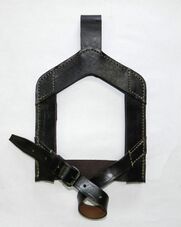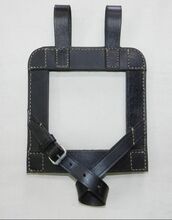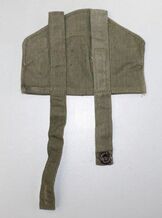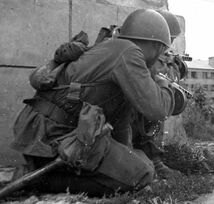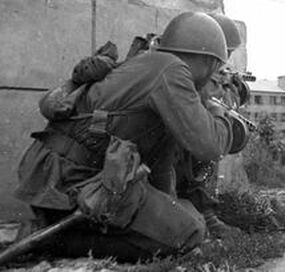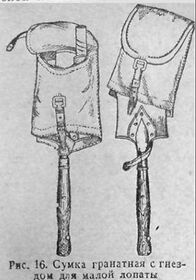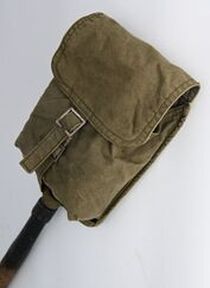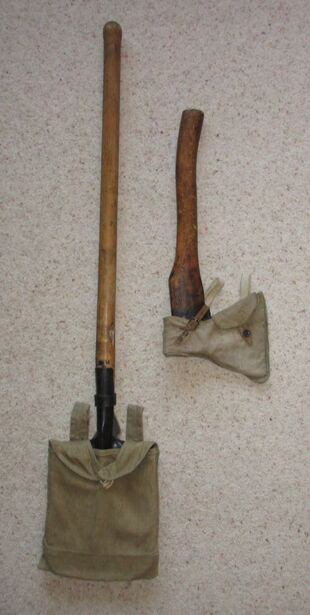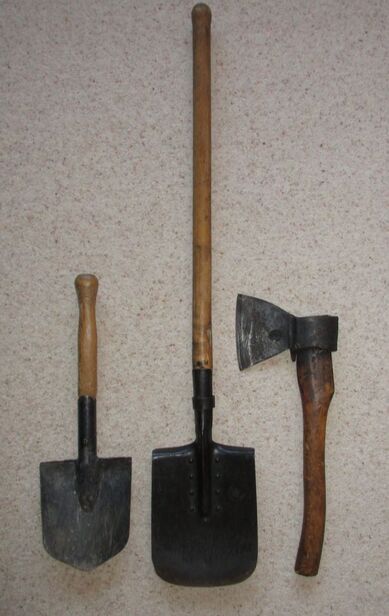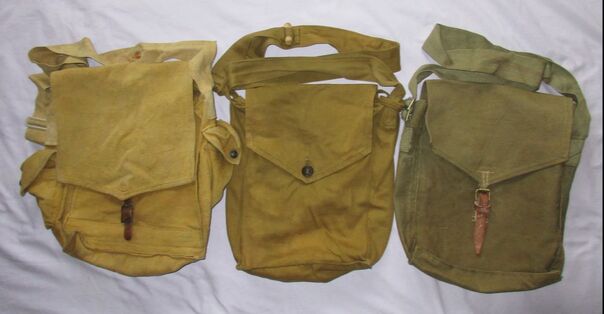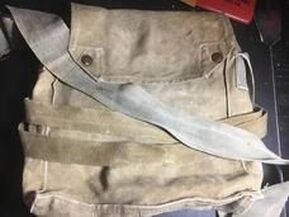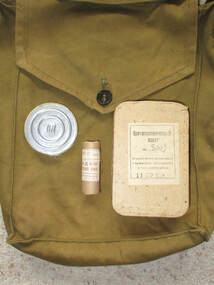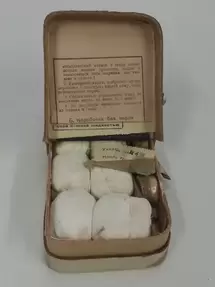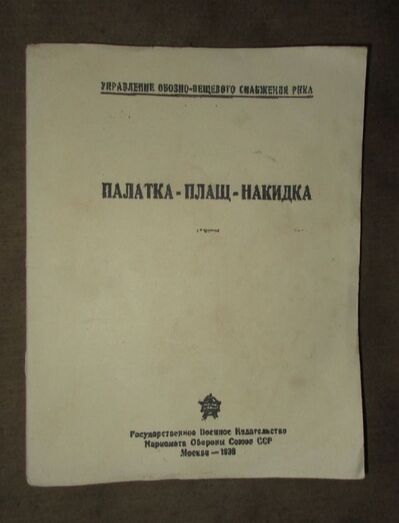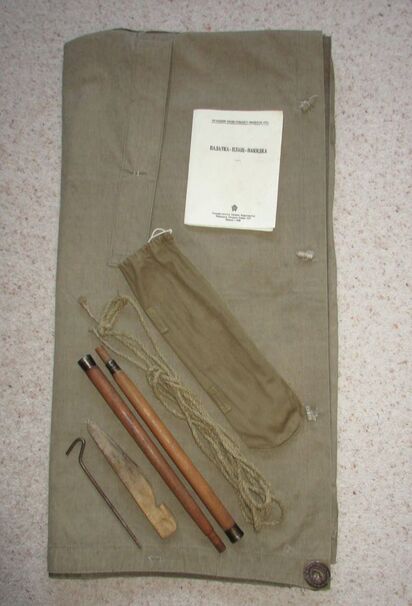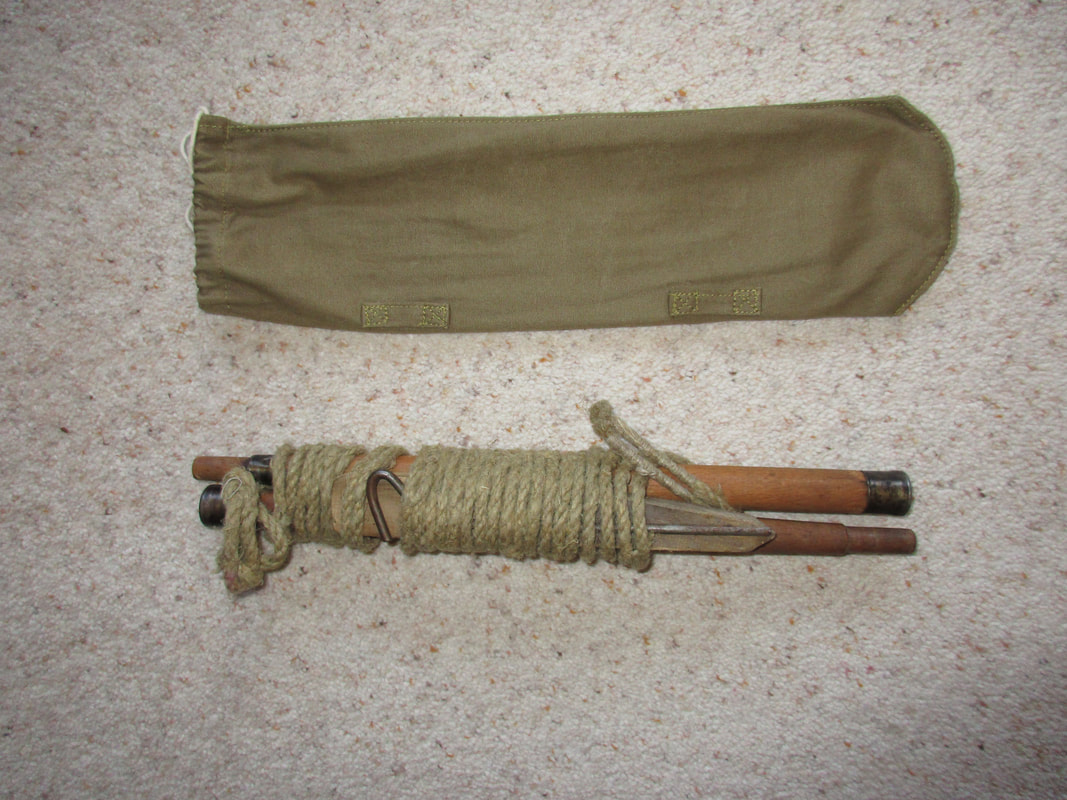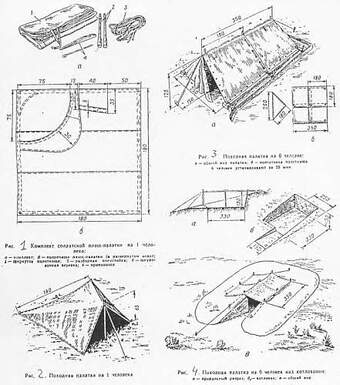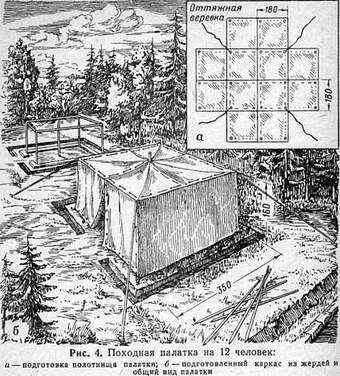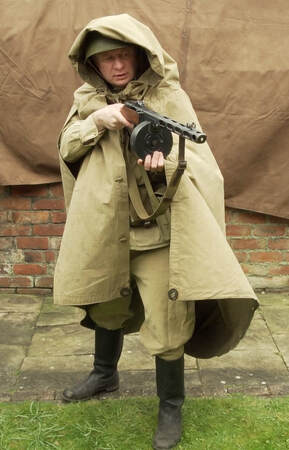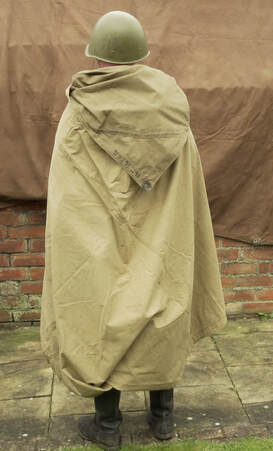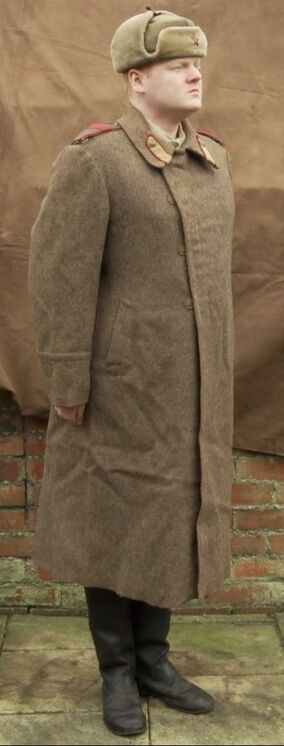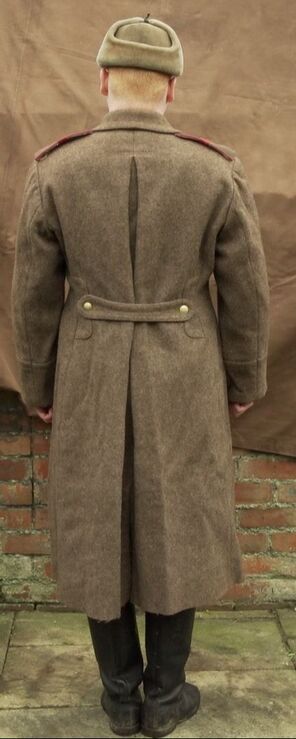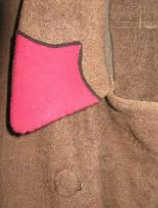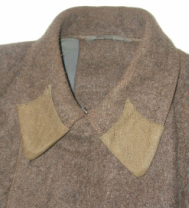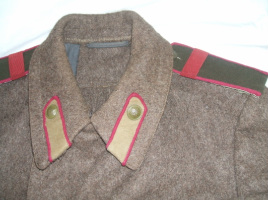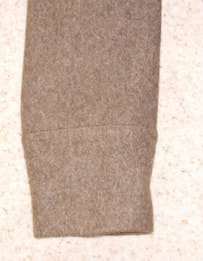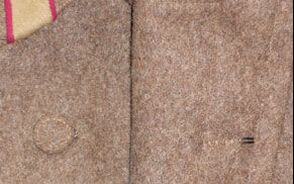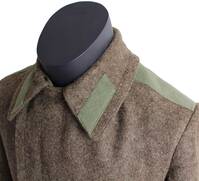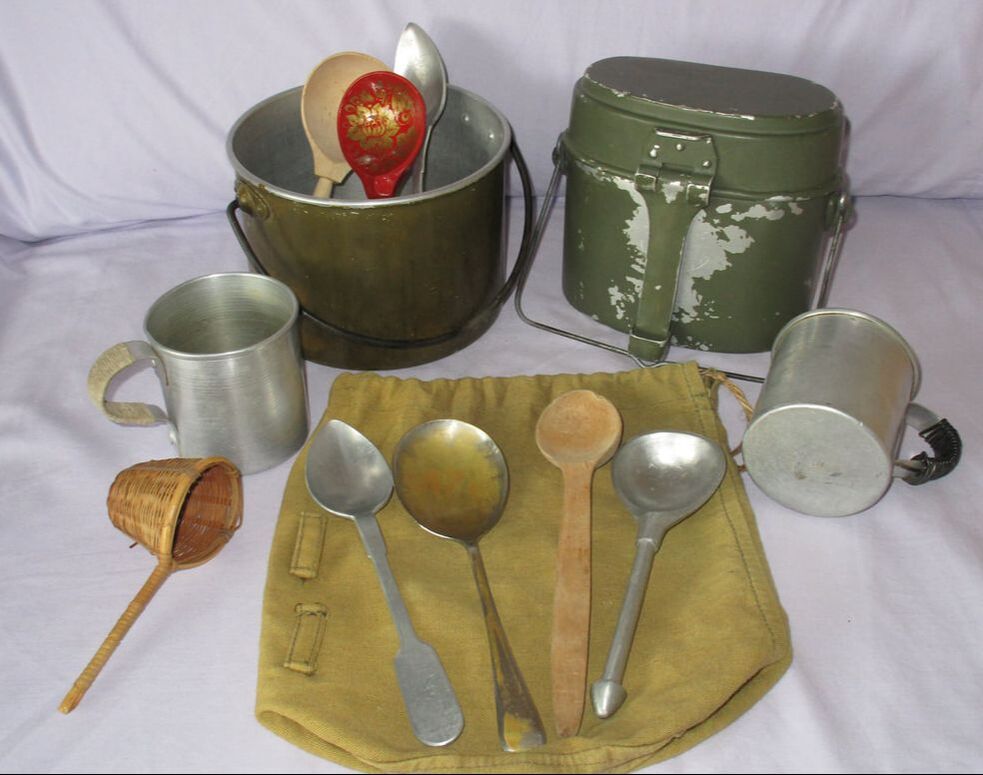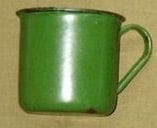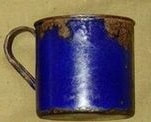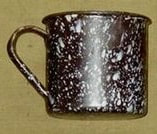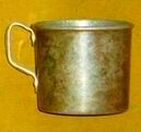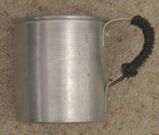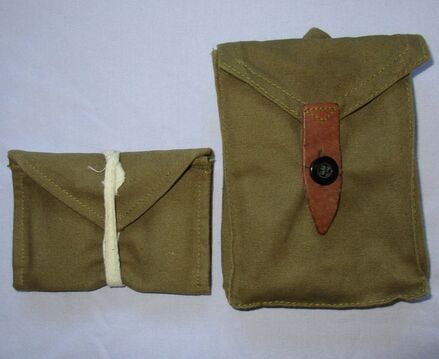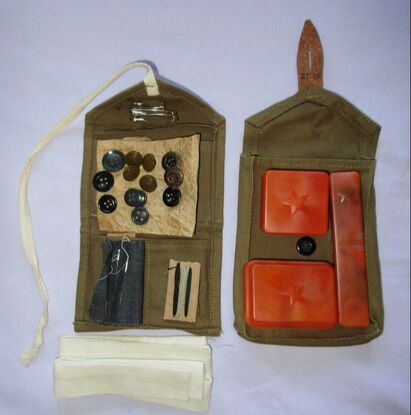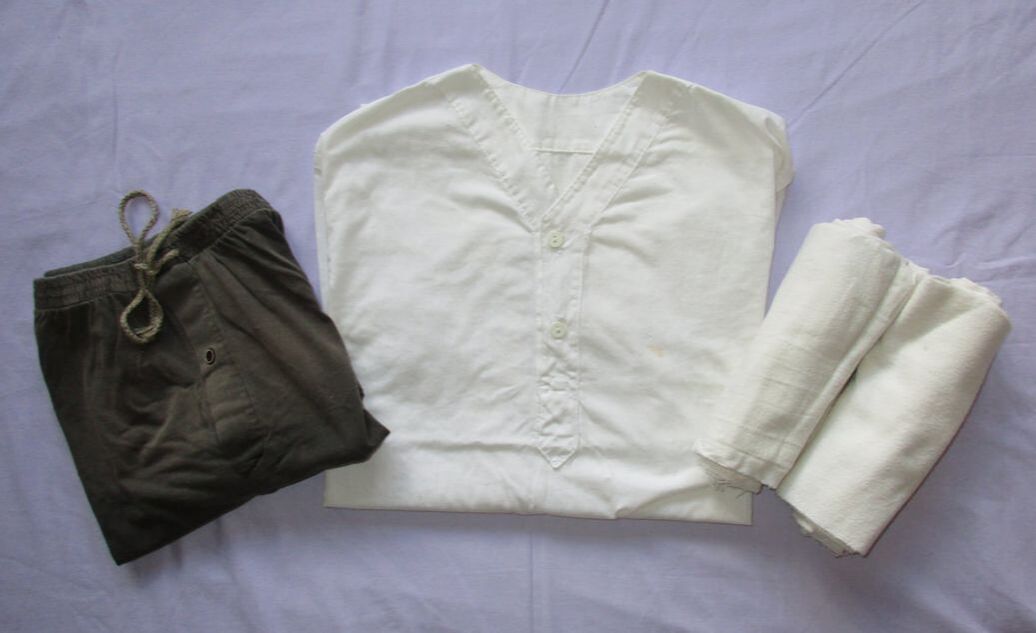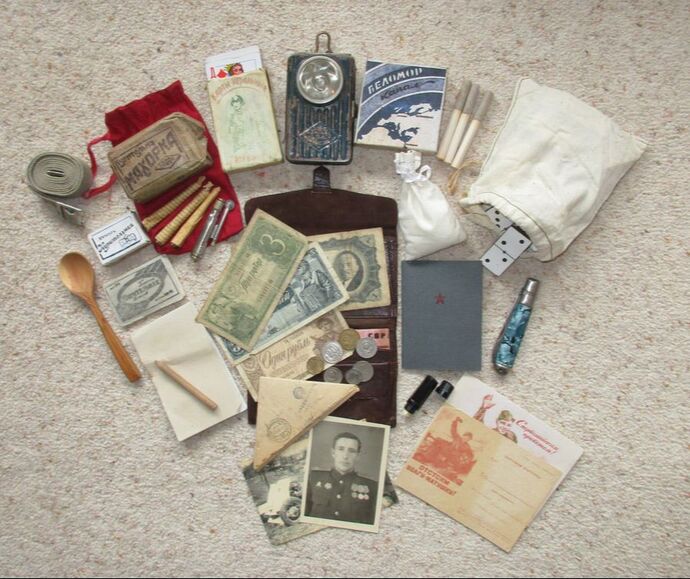Policy and overview on equipment and field gear.
The same policy on authenticity as described in the uniform section applies to equipment and field gear and is intended to provide some guidance to members obtaining the correct items for their impression. Again, the emphasis should be to initially obtain mid to late war kit.
By the mid 1930s the Red Army was the largest army in the world and was just as well equipped as any other army of the day. At the outbreak of the Great Patriotic War in June 1941, the land forces approximately made up 85 % of the total manpower,of which 75% consisted of Rifle (Infantry) units, the VVS (Air Force) 11% and the VMF (Navy) 4%.
A total of 34,476,700 Soviet citizens from all the states of the USSR served in the armed forces during the course of the war years.
The first year of the war was disastrous for the Soviet Union, as by the end of December 1941 had resulted in the loss of over five million men killed, captured or missing, as well as vast amounts of weapons, equipment and materiel lost. Due to the rapid advances made by the Germans, most of the Soviet Unions industrial and manufacturing capacities in the west were over run or had to be transferred east to the Urals, so as to continue production. Therefore 1942 was an austere period for the Soviets and the quality and quantity of the soldiers equipment became quite rudimentary and basic. Also, there was an increased use of synthetic and replacement materials. Often as a consequence soldiers were infrequently issued with a full compliment of equipment and field gear. As the war progressed there was some improvement, particularly in Guards units, who generally tended to be better manned and equipped than other line Rifle units.
As seen in photographic archives of Red Army soldiers during the war, there was a vast array of appearances in both uniform and equipment. This was due to the fact that it was being manufactured in factories and workshops all across the Soviet Union and that local interpretation and materials available resulted in some variations on the same patterns of uniform and equipment being produced.
By the mid 1930s the Red Army was the largest army in the world and was just as well equipped as any other army of the day. At the outbreak of the Great Patriotic War in June 1941, the land forces approximately made up 85 % of the total manpower,of which 75% consisted of Rifle (Infantry) units, the VVS (Air Force) 11% and the VMF (Navy) 4%.
A total of 34,476,700 Soviet citizens from all the states of the USSR served in the armed forces during the course of the war years.
The first year of the war was disastrous for the Soviet Union, as by the end of December 1941 had resulted in the loss of over five million men killed, captured or missing, as well as vast amounts of weapons, equipment and materiel lost. Due to the rapid advances made by the Germans, most of the Soviet Unions industrial and manufacturing capacities in the west were over run or had to be transferred east to the Urals, so as to continue production. Therefore 1942 was an austere period for the Soviets and the quality and quantity of the soldiers equipment became quite rudimentary and basic. Also, there was an increased use of synthetic and replacement materials. Often as a consequence soldiers were infrequently issued with a full compliment of equipment and field gear. As the war progressed there was some improvement, particularly in Guards units, who generally tended to be better manned and equipped than other line Rifle units.
As seen in photographic archives of Red Army soldiers during the war, there was a vast array of appearances in both uniform and equipment. This was due to the fact that it was being manufactured in factories and workshops all across the Soviet Union and that local interpretation and materials available resulted in some variations on the same patterns of uniform and equipment being produced.
Obr 1936 field equipment.
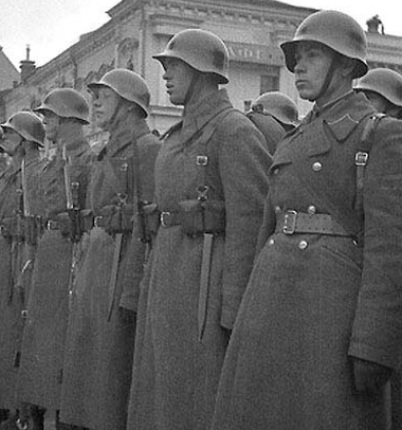
At the outbreak of the war the Obr 1936 field equipment was still quite evident in the field. It was largely made from leather, ie the belt, pouches, straps etc. The rucksack "Ranyets Rioksak", which was similar in appearance to the German "Tornister", but made from canvas on a wooden frame,leather reinforced straps and with a dark green coloured synthetic 'kirza' leather outer flap. This pattern of equipment quickly disappeared from the field during the early months of the war.
Image. Soldiers on parade wearing Obr 1935 greatcoats,with the Obr 1936 pattern Kaska helmets and field equipment.The canvas strap for the gas mask bag is visible worn over the right shoulder. Although not fully discernible in the image, they appear to be armed with either AVS 36 or SVT 38 self loading rifles. This is evident by the apparent length of the bayonets and bayonet frogs seen being worn, which were somewhat longer than that of the later SVT 40 bayonet.
On the right is an officer, distinguished by the buttons on his greatcoat and gold coloured piping on the collar patch and is wearing the Obr 1932 officers pattern leather field belt equipment, from which the side arm and map case was suspended. Note, in a small pouch with lanyard is a whistle worn on the left shoulder, used to convey orders on the battlefield.
Image. Soldiers on parade wearing Obr 1935 greatcoats,with the Obr 1936 pattern Kaska helmets and field equipment.The canvas strap for the gas mask bag is visible worn over the right shoulder. Although not fully discernible in the image, they appear to be armed with either AVS 36 or SVT 38 self loading rifles. This is evident by the apparent length of the bayonets and bayonet frogs seen being worn, which were somewhat longer than that of the later SVT 40 bayonet.
On the right is an officer, distinguished by the buttons on his greatcoat and gold coloured piping on the collar patch and is wearing the Obr 1932 officers pattern leather field belt equipment, from which the side arm and map case was suspended. Note, in a small pouch with lanyard is a whistle worn on the left shoulder, used to convey orders on the battlefield.
The Obr 1936 rucksack.
The loops on the outer flap were used to secure the mess tin in it's canvas cover to the pack. The shoulder straps attached
to the D rings on the ammunition pouches on the front of the wearers belt and the bottom corners of the pack by hooks.
There was also an officers version of the pack, distinguished by the lack of any loops on the outer flap.
The loops on the outer flap were used to secure the mess tin in it's canvas cover to the pack. The shoulder straps attached
to the D rings on the ammunition pouches on the front of the wearers belt and the bottom corners of the pack by hooks.
There was also an officers version of the pack, distinguished by the lack of any loops on the outer flap.
Obr 1938 field equipment.

In 1938 a new pattern of field equipment was authorised and was introduced the following year. There was an increase in the use of canvas and webbing material. The canvas back pack (Ranyets rioksak) had two external pockets with some leather reinforcing and straps and the back and shoulder straps were padded for comfort.
In 1941 a simplified all canvas version with only two leather pocket straps briefly appeared. The great coat could be carried "horse shoe" style over the top of the pack. A small bag for the cape/shelter poles, rope and pegs was strapped underneath the pack.
On the waist belt, two ammunition pouches were worn at the front, the infantry shovel & water canteen on the right hip, the bayonet & grenade pouch was worn on the left hip. The gas mask bag strap was worn over the right shoulder, under the waist belt and the bag hung on the left hip.
On the waist belt under the backpack was carried a small canvas ration bag. The equipment worn on the waist belt was supported by canvas webbing Y straps worn across the shoulders. Note: as shown, it was not uncommon to see the excess end of the waist belt to be looped through the straps of the left ammunition pouch.
Shown below the right leather ammunition pouch in this image is a canvas pouch, which held an auxiliary ammo supply of thirty rounds.
By early 1942 this pattern had all but disappeared from use in the field as it was too costly to manufacture under wartime production conditions.
In 1941 a simplified all canvas version with only two leather pocket straps briefly appeared. The great coat could be carried "horse shoe" style over the top of the pack. A small bag for the cape/shelter poles, rope and pegs was strapped underneath the pack.
On the waist belt, two ammunition pouches were worn at the front, the infantry shovel & water canteen on the right hip, the bayonet & grenade pouch was worn on the left hip. The gas mask bag strap was worn over the right shoulder, under the waist belt and the bag hung on the left hip.
On the waist belt under the backpack was carried a small canvas ration bag. The equipment worn on the waist belt was supported by canvas webbing Y straps worn across the shoulders. Note: as shown, it was not uncommon to see the excess end of the waist belt to be looped through the straps of the left ammunition pouch.
Shown below the right leather ammunition pouch in this image is a canvas pouch, which held an auxiliary ammo supply of thirty rounds.
By early 1942 this pattern had all but disappeared from use in the field as it was too costly to manufacture under wartime production conditions.
Ranyets rioksak Obr 1938.
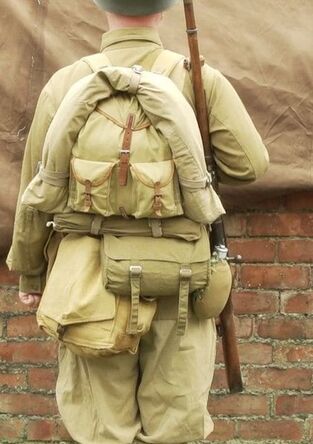
View of the Obr 1938 rucksack.
The plashch palatka cape/shelter is rolled across the rucksack. When the greatcoat was not worn it was carried in the same fashion on the rucksack, either wrapped inside or with the plasch Palatka strapped on top of the coat. On the wearers left hip is a BN gas mask bag. Under the rucksack is the ration bag and on the right hip is the canteen worn over the entrenching shovel.
Each shoulder strap at the front was adjustable and had a hook on it, which attached to a D ring on to the ammunition pouches at the front of the wearers belt. The other ends of the shoulder straps were attached to the bottom corners of the pack, the left one with a D ring and the right one with a hook fitting. This was so that the wearer could put the pack on unassisted. An additional strap and hook on the bottom of the pack could be attached to the back of wearers waist belt, however it was commonly removed by the soldiers in the field. A small pouch, which held the tent/shelter poles, pegs and rope could be attached to the bottom of the pack by straps.
Additionally, each man would have been issued an anti gas cape and salopettes, which were tied to the top of the rucksack and an individual string camouflage net (150 cm x 175 cm) and two hessian sand bags, for use in basic defence positions. Depending on the theatre, a grass coloured raffia camouflage fringe, some 275 cm long was also issued. Apart from the sand bags, generally all fell out of issue during the early period of the war.
The plashch palatka cape/shelter is rolled across the rucksack. When the greatcoat was not worn it was carried in the same fashion on the rucksack, either wrapped inside or with the plasch Palatka strapped on top of the coat. On the wearers left hip is a BN gas mask bag. Under the rucksack is the ration bag and on the right hip is the canteen worn over the entrenching shovel.
Each shoulder strap at the front was adjustable and had a hook on it, which attached to a D ring on to the ammunition pouches at the front of the wearers belt. The other ends of the shoulder straps were attached to the bottom corners of the pack, the left one with a D ring and the right one with a hook fitting. This was so that the wearer could put the pack on unassisted. An additional strap and hook on the bottom of the pack could be attached to the back of wearers waist belt, however it was commonly removed by the soldiers in the field. A small pouch, which held the tent/shelter poles, pegs and rope could be attached to the bottom of the pack by straps.
Additionally, each man would have been issued an anti gas cape and salopettes, which were tied to the top of the rucksack and an individual string camouflage net (150 cm x 175 cm) and two hessian sand bags, for use in basic defence positions. Depending on the theatre, a grass coloured raffia camouflage fringe, some 275 cm long was also issued. Apart from the sand bags, generally all fell out of issue during the early period of the war.
Obr 1938 field gear. Early war.
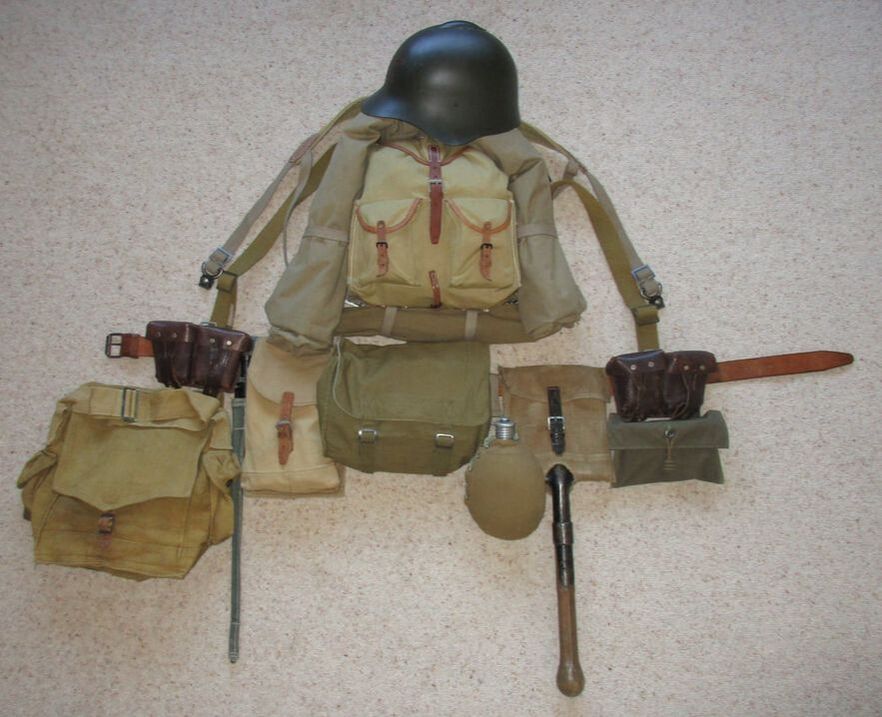
Obr 1939 field equipment. Top: Obr 1936 kaska (helmet), Obr 1938 rioksak, plashch palatka, tent poles, rope and pegs in small pouch attached to bottom of rioksak. Bottom: L to R, BN gas mask bag, leather belt, web 'Y 'straps, Obr 1937 leather ammo pouch, bayonet & frog, RGD 33 grenade pouch, ration bag, water canteen, infantry shovel, leather ammo pouch and canvas reserve ammo pouch. Note: The anti-gas cape and salopettes would have been strapped to the top of the rioksak on top of the rain cape. Also, the bayonet frog was not a common issue item. It was usual for the bayonet to be permanently attached to the rifle. Note; due to losses of materiel and some reduction in manufacturing during late 1941 early 1942, not all the above items would have been issued to troops, who had to make do with whatever was available at that time.
Below: Images of a rifleman in M 1939 marching order June 1941.
Ranyets rioksak Obr 1941.
As the war progressed the equipment became simplified and easier to manufacture, often incorporating replacement and sometimes synthetic materials. Note: the M 1936, M 1938 & M 1941 ranyets rioksak's were only issued to infantry/rifle troops, other branches of service were issued with M 1935 veschevoi myeshok.
Veschevoi myeshok or simple back pack.

The origins of the vesh-meshok date back to the 1850's which was later re-introduced in 1923 with the Red Army. It was originally referred to as the "Turkestan" or "Sidor" bag. It was a simple canvas sack like bag with a draw string at the top, with a canvas strap attached to the bottom of each corner. The strap could be looped around the neck of the bag to form the shoulder straps. A chest strap was fitted with either an adjustable buckle, wooden toggle or tie string arrangement.
The M1935 pattern had a toggle attachment so that one end of the strap could be attached/detached to bottom of the pack. The myeshok introduced in 1941 had both ends of the shoulder strap sewn to the bottom of the pack.
Post war myeshok's have metal buckles attached to the bottom of the pack, which allowed the length of the shoulder straps to be adjusted to the wearer.
(Go to the More section above, Misc. pages on how to tie the pack)
The M1935 pattern had a toggle attachment so that one end of the strap could be attached/detached to bottom of the pack. The myeshok introduced in 1941 had both ends of the shoulder strap sewn to the bottom of the pack.
Post war myeshok's have metal buckles attached to the bottom of the pack, which allowed the length of the shoulder straps to be adjusted to the wearer.
(Go to the More section above, Misc. pages on how to tie the pack)
Podsoomoki dlya patronii or ammo pouches.
The M1891 'Tsarist' ammunition pouch had been in use with the Imperial and then the Red Army until 1936, when the M1937 two section pouch was introduced. The early pouches had a Y closure strap and was in production until the summer of 1941. Thereafter, pouches were produced in varying types by the different factories i.e. Y closure strap, solid closure strap,
differing hardware construction (riveting, stitching etc), but all had a two layer back with belt loops.
On 1st February 1941, the NKO (State Committee of Defence) Order No. 005 authorised the use of kirza synthetic material for ammo pouches together with leather. Production began of two section pouches made with kirza material on the front side of the pocket, the remaining elements were leather. These pouches are extremely rare, with only few known examples surviving. The kirza (Rexine) two section pouches most associated with post war production well into the 1950's, the earliest known example of which is dated 1945.
Below: Top: Pre/early war variations of the Obr 1937 rifle ammunition pouches for the Mosin Nagant rifle. They were made in brown or black leather and each single pouch could hold three 5 round clips.The D ring on the back was used to attach the hooks of the M36, M38 and M41 haversack straps respectively.
Centre: As the M38 and M41 haversacks fell out of use during the early months of the war and the veschevoi myeshok being reintroduced, the necessity of the D ring on the pouch back was no longer required and was omitted.
Bottom: Left: M1891 Tsarist period. During the very early months of the war, this pattern pouch was also seen in use, hence it's inclusion here. Right: In October, 1941 a simplified economy pouch was accepted into service and were produced until 1945. They were made from leather,canvas and kirza material. The pouches could hold four 5 round clips or one SVT magazine.
differing hardware construction (riveting, stitching etc), but all had a two layer back with belt loops.
On 1st February 1941, the NKO (State Committee of Defence) Order No. 005 authorised the use of kirza synthetic material for ammo pouches together with leather. Production began of two section pouches made with kirza material on the front side of the pocket, the remaining elements were leather. These pouches are extremely rare, with only few known examples surviving. The kirza (Rexine) two section pouches most associated with post war production well into the 1950's, the earliest known example of which is dated 1945.
Below: Top: Pre/early war variations of the Obr 1937 rifle ammunition pouches for the Mosin Nagant rifle. They were made in brown or black leather and each single pouch could hold three 5 round clips.The D ring on the back was used to attach the hooks of the M36, M38 and M41 haversack straps respectively.
Centre: As the M38 and M41 haversacks fell out of use during the early months of the war and the veschevoi myeshok being reintroduced, the necessity of the D ring on the pouch back was no longer required and was omitted.
Bottom: Left: M1891 Tsarist period. During the very early months of the war, this pattern pouch was also seen in use, hence it's inclusion here. Right: In October, 1941 a simplified economy pouch was accepted into service and were produced until 1945. They were made from leather,canvas and kirza material. The pouches could hold four 5 round clips or one SVT magazine.
Podsoomoki dlya pistolyet pulyomyeta, CBT, granata ee patronii.
Pouches for submachine guns, SVT rifle, hand grenades and ammunition.
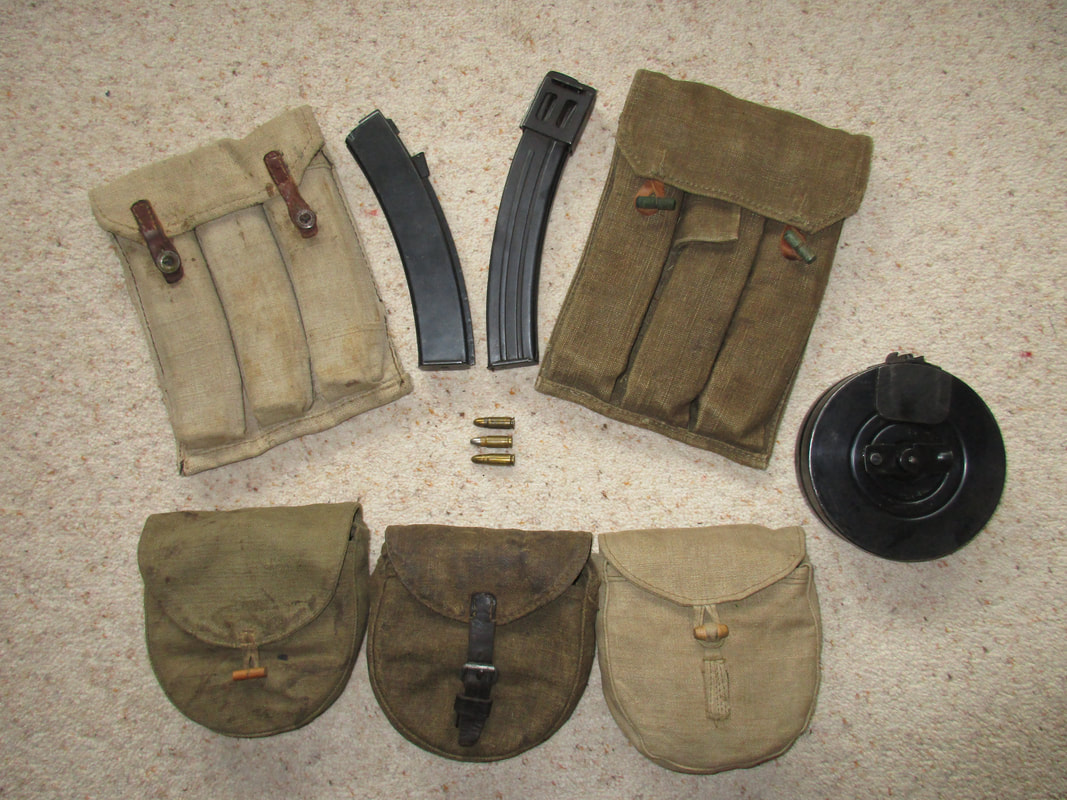
A selection of pouches for use with the PPSh or PPS submachine guns, including the 71 round drum and 35 round curved magazines. The 35 round curved magazines for the PPSh & PPS were not interchangeable.
Top : Left, pouch for three 35 round curved magazines for use with the PPSh and PPS. Centre left PPS magazine, right PPSh magazine (Note, the PPSh magazine that was manufactured during the first year of production was made of a thin gauge metal, which required strengthening ribbing. Thereafter, the magazines were made of a thicker gauge metal and which obviated the ribbing process),Right, 35 round pouch with small pouch attached for the magazine loader and a 71 round drum magazine for the PPSh.
Bottom: Ammunition 7.62 x 25 mm P, for use with PPSh & PPS as well with the Tokarev TT30/33 pistols. PPSh drum magazine pouches. The centre one is an early war type which has a web loop on the back for the Y strap to attach through.
AVS-36 and SVT-38/40 pouches.
With the acceptance of AVS-36, the first self loading rifle in service with the RKKA , special pouches were designed to hold the 15 round magazines. Each pouch could hold two magazines and were bigger than the later introduced SVT-38 &40 10 round magazine pouches.
In 1939 the new self loading rifle SVT-38, and in 1940 SVT-40 entered service respectively. Internally, the pouch was split with horizontal divider for two SVT magazines. Early SVT pouches,1939- early 1941 had D ring. In summer 1941, production of SVT pouches was stopped, and a new simplified model was introduced that could be be used either for SVT magazines or Mosin clips. Internally, there were two folding leather dividers i.e. horizontal for two SVT magazine and vertical for four Mosin clips. Pouches were made in leather, canvas and kirza material with Y closure strap, solid closure strap and differing hardware construction (riveting, stitching etc).
Below: Left , AVS-36 pouch. Centre, SVT-38/40 pouch. Right, SVT-38/40 pouch showing interior magazine divider.
With the acceptance of AVS-36, the first self loading rifle in service with the RKKA , special pouches were designed to hold the 15 round magazines. Each pouch could hold two magazines and were bigger than the later introduced SVT-38 &40 10 round magazine pouches.
In 1939 the new self loading rifle SVT-38, and in 1940 SVT-40 entered service respectively. Internally, the pouch was split with horizontal divider for two SVT magazines. Early SVT pouches,1939- early 1941 had D ring. In summer 1941, production of SVT pouches was stopped, and a new simplified model was introduced that could be be used either for SVT magazines or Mosin clips. Internally, there were two folding leather dividers i.e. horizontal for two SVT magazine and vertical for four Mosin clips. Pouches were made in leather, canvas and kirza material with Y closure strap, solid closure strap and differing hardware construction (riveting, stitching etc).
Below: Left , AVS-36 pouch. Centre, SVT-38/40 pouch. Right, SVT-38/40 pouch showing interior magazine divider.
Below: Top. Interior of of a 1941 simplified SVT-40 pouch.Left to Right, showing horizontal and vertical folding leather dividers, vertical divider folded to hold two SVT magazines and horizontal divider folded to hold four 5 round Mosin clips.
Bottom. A 1941 SVT pouch and magazine and 5 round clip. An economy SVT-40 pouch, similarly produced in canvas and kirza material.
In 1941, the WW1 chest pouch (bandoleer) was reintroduced. 1941 bandoleers mostly had six pockets only for ammunition in clips, but some also had a pocket for a SVT magazine. Versions with the SVT magazine pocket were only produced in 1941-1945.
Below: An economy made ammunition bandolier which was worn over a shoulder and across the chest. It could hold up to 70 rounds in clips of the standard 7.62 x 54 R ammunition, or 50 rounds and a SVT magazine. A canvas auxiliary pouch was worn on the waist belt below the right ammo pouch and was for spare ammunition , i.e. up to 20 rounds in clips or in loose rounds. It was closed by various means i.e. a button or wooden toggle with leather or tape strap or hemp string, as shown below.
Below: An economy made ammunition bandolier which was worn over a shoulder and across the chest. It could hold up to 70 rounds in clips of the standard 7.62 x 54 R ammunition, or 50 rounds and a SVT magazine. A canvas auxiliary pouch was worn on the waist belt below the right ammo pouch and was for spare ammunition , i.e. up to 20 rounds in clips or in loose rounds. It was closed by various means i.e. a button or wooden toggle with leather or tape strap or hemp string, as shown below.
An example of a Soviet wooden ammunition box which contained 600 x 7.62 mm rounds. The rounds were contained in two galvanised steel hermetically sealed cans, each holding 300 rounds. Externally, information of the contents was stencilled on i.e. calibre, bullet & cartridge type, manufacture month/year and factory code, powder type ( BT i.e. for rifles), lot year manufactured, powder factory code and total number of rounds.The box lid was held in place by a metal strap which wrapped around the entire box centrally. Also, colour coded painted stripes were appended, which additionally indicated tracer, armour piercing, sniper etc. Included within was an metal opener device for opening the sealed cans within, shown right. The example in the image is post war, dated July 1951, but is exactly the same as wartime manufactured ones.
Grenade Pouches.
Below Right: is a pouch for the F-1 grenade. The F-1 grenade was adopted for service in 1939 and on 29th June that year, the head of ABTVoisk(Armoured Forces of the RKKA) approved the issue of a pouch for the F-1 grenade, which was to hold three grenades. It was issued for use by tank, SP gun and armoured car crews for defensive purposes and was stored in a dedicated storage compartment within the respective vehicle. The pouch cover could be secured by various means i.e. leather strap and buckle, a single central button and hemp loop or by two wooden toggles and hemp/leather loops. The pouches had cloth loops on the back, which would allow it to be worn on a belt by the crew member when dismounted from the vehicle and when the vehicle became damaged and had to be abandoned.
There is some debate as to when they went into mass production and whether these pouches were actually an official infantry issue item, although there are a numerous period images of infantry wearing them, it is viewed they were primarily only issued to armoured forces. The standard TO&E issue of front line infantry was two grenades, but would be increased depending on the operation i.e. urban house clearing etc. Order No. 145 on clothing items dated 14th May 1942, state a grenade bag being registered for 2 grenades only, not 3. By the late summer of 1942 F-1 grenade pouches went on supply for infantry units. Based on the period of a specific reconstruction,the F-1 pouches would therefore not be suitable for pre and early war infantry impressions.
Below Left: is a universal pouch issued to infantry troops for use with either the RG-14/30 or RGD 33 stick grenade and the also for the F-1 and RG-42 grenades.It could hold two RG-14 \ 30 or RGD-33 grenades and there is a small internal pocket to hold fuses. It could hold up to four F-1 grenades, with special instructions on how the grenades and fuses were to be stored within. The use of the RGD-33 grenade did not continue after the war, hence this pouch went out of use. Also in use during the war was a simplified economy RGD-33 pouch using less material and did not have the outer flap cover. The two inverted grenade heads were held in smaller individual tubular pockets and the uppermost handles were secured in place with two tie tapes.
Below Right: is a pouch for the F-1 grenade. The F-1 grenade was adopted for service in 1939 and on 29th June that year, the head of ABTVoisk(Armoured Forces of the RKKA) approved the issue of a pouch for the F-1 grenade, which was to hold three grenades. It was issued for use by tank, SP gun and armoured car crews for defensive purposes and was stored in a dedicated storage compartment within the respective vehicle. The pouch cover could be secured by various means i.e. leather strap and buckle, a single central button and hemp loop or by two wooden toggles and hemp/leather loops. The pouches had cloth loops on the back, which would allow it to be worn on a belt by the crew member when dismounted from the vehicle and when the vehicle became damaged and had to be abandoned.
There is some debate as to when they went into mass production and whether these pouches were actually an official infantry issue item, although there are a numerous period images of infantry wearing them, it is viewed they were primarily only issued to armoured forces. The standard TO&E issue of front line infantry was two grenades, but would be increased depending on the operation i.e. urban house clearing etc. Order No. 145 on clothing items dated 14th May 1942, state a grenade bag being registered for 2 grenades only, not 3. By the late summer of 1942 F-1 grenade pouches went on supply for infantry units. Based on the period of a specific reconstruction,the F-1 pouches would therefore not be suitable for pre and early war infantry impressions.
Below Left: is a universal pouch issued to infantry troops for use with either the RG-14/30 or RGD 33 stick grenade and the also for the F-1 and RG-42 grenades.It could hold two RG-14 \ 30 or RGD-33 grenades and there is a small internal pocket to hold fuses. It could hold up to four F-1 grenades, with special instructions on how the grenades and fuses were to be stored within. The use of the RGD-33 grenade did not continue after the war, hence this pouch went out of use. Also in use during the war was a simplified economy RGD-33 pouch using less material and did not have the outer flap cover. The two inverted grenade heads were held in smaller individual tubular pockets and the uppermost handles were secured in place with two tie tapes.
Flyaga or water canteen.
Left-Right: wartime 750 ml flasks.(flyagye) 1931/32 aluminium flask in a 1937 pattern carrier, similar in appearance to the German Army carrier. A simplified carrier was also in use, which retained the belt loop clip attachment, the string and metal eyelets were replaced by a simple draw string at the top, similar to the M1941 type. 1931/32 aluminium flask. 1931/32 aluminium flask in a 1941 pattern carrier, with draw string top, the belt loop was held over the flask neck with a strap and was secured with either a metal,leather, plastic/Bakelite buttons or a wooden toggle on the front. An economy variant of this carrier was also in use i.e. the belt loop, button and strap was omitted, the draw string was retained and two simple fabric belt loops were attached to the back. Glass flask, which first introduced in February 1932 and were produced from glass in different colours. The different colours were a result of the composition of the raw materials used during manufacturing. It was produced in 0.75 ml and 1 litre capacities.
War time canteens are clearly distinguishable from late post war variants. Prewar time examples were unpainted aluminium, before the 1940 order which stipulated that canteens and mess kits were to be painted with 4BO protective paint. The canteens were ovate in shape (longitude egg shaped in appearance). The main difference between the pre-war flasks, produced from 1937 and 1941, is the presence of five threads on the neck and the threaded cap. Post war flasks produced from 1948 on wards have three threads on the neck and the threaded cap, which have wider threading.On the top of the cap was a small metal chain, which secured it to the neck of the flask. Marking of the manufacturer and the date year were stamped on the bottom of the flasks.Canteens were worn in canvas condensation carriers (chekhol k flyagye),which was attached to the waist belt and near the entrenching tool on the right hip.
Flasks produced in the 1920's and 30's and were based on the earlier 1899 'Imperial type' were also seen in use during the early stages of the war.
The capacity of the standard aluminium canteen was 750 ml, whereas field combat medics and other specialist personnel
(construction battalions, sappers, signalmen, etc) carried a larger 1 litre capacity aluminium canteen, usually in canvas carrier with a long strap which was worn over the shoulder.
In an effort to reduce the use of aluminium, which was essential to other wartime manufacture, i.e. aircraft production, alongside the aluminium flask, a glass variant was also produced, which had a black rubber stopper, simply secured by string to the neck. A glass flask was substantially heavier than the aluminium type, i.e. with a filled capacity of 0.75 litres it weighed 450 grams, whereas an aluminum flask with a filled capacity of 0.75 litres weighed 183 grams! Glass flasks sometimes were seen worn in quilted padded covers, to soften possible blows and reduce damages.
Flasks produced in the 1920's and 30's and were based on the earlier 1899 'Imperial type' were also seen in use during the early stages of the war.
The capacity of the standard aluminium canteen was 750 ml, whereas field combat medics and other specialist personnel
(construction battalions, sappers, signalmen, etc) carried a larger 1 litre capacity aluminium canteen, usually in canvas carrier with a long strap which was worn over the shoulder.
In an effort to reduce the use of aluminium, which was essential to other wartime manufacture, i.e. aircraft production, alongside the aluminium flask, a glass variant was also produced, which had a black rubber stopper, simply secured by string to the neck. A glass flask was substantially heavier than the aluminium type, i.e. with a filled capacity of 0.75 litres it weighed 450 grams, whereas an aluminum flask with a filled capacity of 0.75 litres weighed 183 grams! Glass flasks sometimes were seen worn in quilted padded covers, to soften possible blows and reduce damages.
Malaya Pekhotnaya Lopata-50 or Small Infantry Shovel-50.
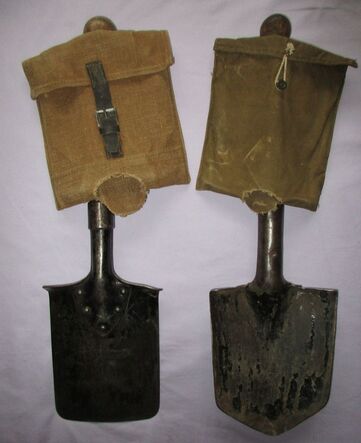
Left: Prewar square blade shovel. Right: late war shovel, both with canvas carriers.
The MPL-50 original shovel was of Danish design in 1869 and adopted by the Russian Imperial Army in 1870 and followed by other European armies and changed little in appearance throughout its respective use in the armies of Imperial Russia and the Soviet Union.
Pre and early war infantry entrenching shovels were manufactured in three metal pieces and were riveted together and were similar in appearance to the German shovel.The blade mount has 5 rivets, the handle fitted in a socket mount of 9.5 cm (3.75 in) and is secured by 1 rivet and metal collar ring. They came in both pentagonal pointed and square blade ends. Later pattern wartime shovels were crudely manufactured and made from two metal pieces welded together and were made with a pointed blade only. The handle was mounted in a socket of 9.5 cm (3.75 in) and was secured by a single rivet.
Both types had wooden unpainted roughened handles, which were fire singed which created a non slip surface in the hand and protruded 23 cm (9 in) out of the socket. The total length of the shovel was 50 cm (20 in),the steel blade is 15 cm (5.9 in) wide and 18 cm (7.1 in) long and it is sharpened on its working edge. As well as for entrenching it had a number of uses i.e. it was often sharpened on one side for use as an axe or the flat of the blade as a hammer or as a work surface, it could serve as an oar for use with improvised rafts, as a frying pan for cooking food over a fire and as a means of measuring, as its length and width are standardized sizes and also as a close quarter fighting weapon!
The pre and early war carriers were made in leather, similar in appearance to the German pattern, for both square and pentagonal shovels. Later carriers were made from canvas with either buckle, button or toggle fasteners, as above images. Economy examples further reduced materials used to manufacture and even a combined shovel carrier and grenade pouch configuration was produced, which could hold two RGD 33 or four F1 grenades.The shovel was worn on the belt on the right hip. A folding handle design ed shovel was never approved or adopted by the Soviets during the war as was by the German and US armies for example.
Note: Generally, an infantry section of nine troops, seven could have carried a MPL-50 shovel and two could have carried a small infantry axe for use in constructing basic defensive positions. In prepared defensive situations, additional tools would have been issued to supplement the standard infantry issue i.e. large shovels,long handled axes,large pick axe,large double handed 2 man wood saws etc, which were standard issue in engineer and construction units. The shovels,axes and pick axes each had their respective canvas carrying pouches.
Above L-R. A pair of pre war leather carriers for both pentagonal and square shovels. A late war variant canvas economy carrier for a pentagonal shovel.Note: material is kept to the minimum, sufficient to cover only half the shovel blade, which combines both the belt loops and shovel handle securing straps and is held by a single metal button. Below L-R. A wartime image of a Soviet soldier wearing a combined shovel and grenade pouch carrier, which was introduced in 1941 intending to reduce the number of pouches worn on the waist belt. Note the handle of a RGD 33 grenade protruding from the top of the carrier. It could hold three RGD 33 or four F1 grenades. These variants appeared to have been less frequently issued.Image of the combination pouch from a period equipment manual and a modern reproduction pouch.
Larger field tools.
Left: The Large Sapper Shovel and the Large Sapper Axe with their respective canvas carry covers. On the march, they were attached to the left rear of the equipment waist belt, with each of the wooden handles worn uppermost, which were secured under the rucksack shoulder straps or with a small buckled strap. When both the shovel and axe were carried together, the axe was usually worn overlaying the shovel with both handles strapped together. Right: The large sapper shovel and axe shown alongside the standard infantry shovel for comparison. The sapper shovel blade was 20 cm wide and 26 cm high,the handle socket was attached to the blade with nine rivets making the total height of the blade and socket 40 cm high. The wooden handle was attached in the socket with one rivet and metal collar ring and the total length of the shovel was 110 cm.
The axe was produced in three sizes. Length with haft. Axe head length. Axe head cutting edge.
Large: 53.3 cm. 22.2 cm. 17.5 cm.
Medium: 44.4 cm. 20 cm. 16.2 cm.
Small: 35.6 cm. 16.5 cm. 13.5 cm.
The small infantry axe was worn on the infantry equipment waist belt in a canvas carrier in the same position as the infantry shovel would have been attached, with the handle worn lowermost. Pick axes were produced in large and medium sizes, which were issued with a long narrow tubular canvas pouch with an adjustable shoulder strap, which held the disassembled pick head and the wooden haft, which protruded uppermost.
The axe was produced in three sizes. Length with haft. Axe head length. Axe head cutting edge.
Large: 53.3 cm. 22.2 cm. 17.5 cm.
Medium: 44.4 cm. 20 cm. 16.2 cm.
Small: 35.6 cm. 16.5 cm. 13.5 cm.
The small infantry axe was worn on the infantry equipment waist belt in a canvas carrier in the same position as the infantry shovel would have been attached, with the handle worn lowermost. Pick axes were produced in large and medium sizes, which were issued with a long narrow tubular canvas pouch with an adjustable shoulder strap, which held the disassembled pick head and the wooden haft, which protruded uppermost.
Soomki dlya protivogaznaya or gas mask bag.
Gas mask bags. Top left to right: M 1936 with two external side pouches(for storage of below accessories), economy M 1940 variant, M 1940 onwards variants, MT-4, MO-2 & ShM-1 without side pouches. Below left to right: M-28 gas mask bag (seen during opening months of the war), gas mask accessories, small tin containing spare eye piece lenses, eye lens demister wax stick & gas decontamination kit, which was used to remove chemical agents from exposed skin and the contents of the decontamination kit.
There were a number of patterns of gas masks,filters and accompanying bags in use by the RKKA and in general there were three types of gas mask filters in use during the course of the war.
The T-4 filter, which replaced the earlier T-5 model, was in use from the mid 1930's with the the Mod 0-8 mask during the opening months of the war. Due to losses of men and equipment during that period it was not commonly seen after 1941.
The MT-4 filter was in use from 1938 up to 1944 and was the standard issue for the RKKA during the 1941-43 period and was used with both the Mod O-8 and ShM-1 masks.
The MO-2 filter was produced from 1943 until the mid 1950's and was slightly smaller and lighter than the other filters. During the war it was used with the ShM-1 mask.
Also seen during the very early war period was the M1928 gas mask bag, which was smaller in size to the other bags and was similar in appearance to the British SBR WW1 gas mask bag i.e. the bag closing flap had the corners folded and stitched inside and was closed with metal press studs. An economy bag appeared early war, which had two buttons with hemp loops instead of the metal press stud closures.Internally it had two compartments and a small pocket for spare lenses and demisting wax.
The bag distinguished by its two small external pouches on the sides M1936, which held the individual decontamination kit and demisting wax, was associated with the pre and early war T-5 and T-4/Mod 0-8 variants and was the largest of the wartime issue bags. It is often referred by the post war misnomer of the BN gas mask bag. Bags for the MT-4 and MO-2
filters and ShM-1 masks, the M1940 variants were without any external side pouches.
Internally, the bags were generally divided into three distinctive smaller compartments in which to store the various components i.e. mask, hose, filter and also a small pocket for spare mask lens and demisting wax. In the bottom of the compartment for the filter, a metal concertina coil spring was fixed to prevent fouling of the filter intake when in use inside the bag.The original issue patterns for these gas masks bags were of good construction and quality. During 1942 simplified economy gas mask bags were introduced and were made from various inferior materials, fastenings, buttons,toggles and wooden blocks replacing the internal metal spring etc and gradually replaced stocks of previous issues.
During the war gas masks were largely withdrawn from service or discarded and the bags were used to carry personal items, ammo or rations etc. For this reason the gas masks are not covered here in the equipment section. The bag was worn over the right shoulder and hung on the left hip.
Note: The often used terms BN and BS gas masks are not a reference of the model/type of filter or the mask it was used with, but define whether the variant was obsolete and not on issue(BN) or was in current issue(BS)with the RKKA and again is a post war misnomer. Also, there were other specialist filters in use issued to tank and air crews respectively.
The T-4 filter, which replaced the earlier T-5 model, was in use from the mid 1930's with the the Mod 0-8 mask during the opening months of the war. Due to losses of men and equipment during that period it was not commonly seen after 1941.
The MT-4 filter was in use from 1938 up to 1944 and was the standard issue for the RKKA during the 1941-43 period and was used with both the Mod O-8 and ShM-1 masks.
The MO-2 filter was produced from 1943 until the mid 1950's and was slightly smaller and lighter than the other filters. During the war it was used with the ShM-1 mask.
Also seen during the very early war period was the M1928 gas mask bag, which was smaller in size to the other bags and was similar in appearance to the British SBR WW1 gas mask bag i.e. the bag closing flap had the corners folded and stitched inside and was closed with metal press studs. An economy bag appeared early war, which had two buttons with hemp loops instead of the metal press stud closures.Internally it had two compartments and a small pocket for spare lenses and demisting wax.
The bag distinguished by its two small external pouches on the sides M1936, which held the individual decontamination kit and demisting wax, was associated with the pre and early war T-5 and T-4/Mod 0-8 variants and was the largest of the wartime issue bags. It is often referred by the post war misnomer of the BN gas mask bag. Bags for the MT-4 and MO-2
filters and ShM-1 masks, the M1940 variants were without any external side pouches.
Internally, the bags were generally divided into three distinctive smaller compartments in which to store the various components i.e. mask, hose, filter and also a small pocket for spare mask lens and demisting wax. In the bottom of the compartment for the filter, a metal concertina coil spring was fixed to prevent fouling of the filter intake when in use inside the bag.The original issue patterns for these gas masks bags were of good construction and quality. During 1942 simplified economy gas mask bags were introduced and were made from various inferior materials, fastenings, buttons,toggles and wooden blocks replacing the internal metal spring etc and gradually replaced stocks of previous issues.
During the war gas masks were largely withdrawn from service or discarded and the bags were used to carry personal items, ammo or rations etc. For this reason the gas masks are not covered here in the equipment section. The bag was worn over the right shoulder and hung on the left hip.
Note: The often used terms BN and BS gas masks are not a reference of the model/type of filter or the mask it was used with, but define whether the variant was obsolete and not on issue(BN) or was in current issue(BS)with the RKKA and again is a post war misnomer. Also, there were other specialist filters in use issued to tank and air crews respectively.
Plashch palatka or rain cape/shelter.
An important and versatile item of equipment, which offered rudimentary protection from the elements to the Red Army soldier.
It was a square in shape, measuring some 180 x 180 cm and made from a canvas water proof duck material with draw strings incorporated into one corner. The strings could be used to tie the cape across the shoulders and also to form a hood. Small toggles and holes along the front edges were used to fasten the cape up and an arm vent was incorporated into the right front. Each corner also had a leather grommet.
When issued, the cape came with a 4.5 metre length of rope, two 37 cm long tapered inter connectable metal reinforced wooden tent poles, one wooden and one metal stake, and when combined with other capes it could be made into a basic 2, 4 or 6 man tent shelter. 12 capes could be combined to form a square shaped shelter to accommodate a section of soldiers. Due to wear and loss the tents were more than often erected using sticks and branches cut in situ locally.
Late post war capes can be identified by the use of brass grommets, metal dished buttons instead of wooden toggles and with two small straps sewn onto one corner, used to attach cape to the modern backpack. With a little effort post war capes can be converted to look like a wartime one. When not being worn the capes were often carried rolled "horse shoe" fashion over the left shoulder.
It was a square in shape, measuring some 180 x 180 cm and made from a canvas water proof duck material with draw strings incorporated into one corner. The strings could be used to tie the cape across the shoulders and also to form a hood. Small toggles and holes along the front edges were used to fasten the cape up and an arm vent was incorporated into the right front. Each corner also had a leather grommet.
When issued, the cape came with a 4.5 metre length of rope, two 37 cm long tapered inter connectable metal reinforced wooden tent poles, one wooden and one metal stake, and when combined with other capes it could be made into a basic 2, 4 or 6 man tent shelter. 12 capes could be combined to form a square shaped shelter to accommodate a section of soldiers. Due to wear and loss the tents were more than often erected using sticks and branches cut in situ locally.
Late post war capes can be identified by the use of brass grommets, metal dished buttons instead of wooden toggles and with two small straps sewn onto one corner, used to attach cape to the modern backpack. With a little effort post war capes can be converted to look like a wartime one. When not being worn the capes were often carried rolled "horse shoe" fashion over the left shoulder.
Below is an extract from the 1938 instruction manual, showing images of the combination of the plashch palatkas to make a variety of shelters and it being worn as a simple rain cape.
FURTHER INFORMATION ON THE PLASHCH PALATKA IS INCLUDED IN THE MISCELLANEOUS SECTION.
Basic mid to late war belt equipment.
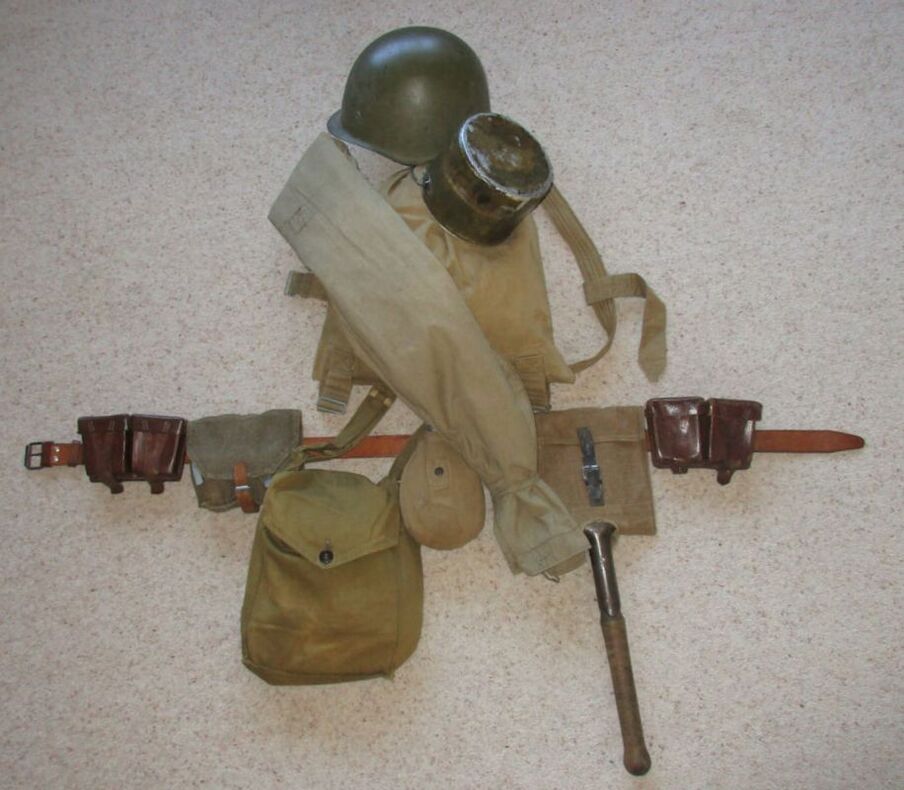
This image shows the basic layout for the rifleman's belt equipment mid to late war period i.e. an EM pattern leather belt, two pairs of ammo pouches, grenade pouch,a water canteen, economy made gas mask bag, shovel, rain cape, simple backpack, mess tin and Obr 1940 steel helmet.
Due to losses and shortages of equipment during the war not all equipment would have been available to all troops, who had to make do with whatever was available. However, Guards rifle units tended to be better supplied and equipped than standard rifle units during the war.
These are the items which new members should acquire for the initial field gear impression.
Shinel or greatcoat.
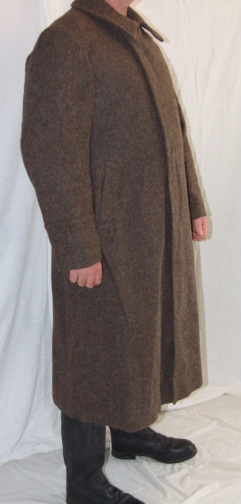
Obr 1941 pattern greatcoat.
During the war period two patterns of the шинель, Shinel the Russian word for military greatcoat, would have been encountered, namely the Obr 1935 and Obr 1941.
Obr 1935 patterns appeared to be a lighter coloured beige/greyish material and the cuff turn ups were pointed at the top at the back of the cuff and the collar appeared larger.The collar could be turned up and the sleeve cuffs could be turned down in inclement weather. They are considered a better quality than Obr 1941 pattern. Inside the left cuff was a concealed pocket for a field dressing, which was not present on the Obr 1941 coat.
The Obr 1941 pattern were made of a brownish mixed wool material and appeared of a somewhat rough and shoddy appearance. The following features were common to both pattern greatcoats i.e a four "hook and eyelet" fastening down the front right side of the coat, a large collar which could be turned up in cold weather conditions,a half belt
(hylastic) held with two 22mm buttons on the small of the back, a vent in the rear coat skirt and with a vertical pocket slit was on each coat hip. The Obr 1941 coat had
horizontal cut false turn ups on the sleeve cuffs which could not be folded down. The rear of the waist belt was to be worn above the half belt. Often when issued, the soldier was required to cut the bottom edge to a length appropriate to the wearers height.
The rank and branch insignia were worn on the collar gorget patches on the Obr 1935 and Obr 1941 coats. When the Obr 1943 pattern rank and branch insignia was introduced, a cloth loop and button was worn on each shoulder where the pogonii were attached to the greatcoat. Also, pitlitsii collar patches in branch of service colours with a single 22mm button was attached on each collar point.The shoulder boards were afixed using 18mm buttons.
Officers coats were of a better quality and finish and were distinguished from EM patterns by the buttons on the coat front. The Obr 1935 pattern had two rows of four buttons, horizontal hip pockets with flap covers and pointed cuff turn ups. The Obr 1941 pattern had two rows of five buttons down the front, horizontal pockets at the hips with flap covers and horizontal cut turn ups on the sleeve cuffs.
When not worn they were carried over the left shoulder, often wrapped inside the cape for protection in a bedroll fashion and was known as a "Skatka". Not just a winter item, greatcoats were carried all year round and were used in conjunction with the rain cape, whereby the soldier would use it as a blanket for sleeping in, as blankets were not issued for field use.
SEE MISCELLANEOUS SECTION ON HOW TO ROLL A GREATCOAT "SKATKA" .
Obr 1935 patterns appeared to be a lighter coloured beige/greyish material and the cuff turn ups were pointed at the top at the back of the cuff and the collar appeared larger.The collar could be turned up and the sleeve cuffs could be turned down in inclement weather. They are considered a better quality than Obr 1941 pattern. Inside the left cuff was a concealed pocket for a field dressing, which was not present on the Obr 1941 coat.
The Obr 1941 pattern were made of a brownish mixed wool material and appeared of a somewhat rough and shoddy appearance. The following features were common to both pattern greatcoats i.e a four "hook and eyelet" fastening down the front right side of the coat, a large collar which could be turned up in cold weather conditions,a half belt
(hylastic) held with two 22mm buttons on the small of the back, a vent in the rear coat skirt and with a vertical pocket slit was on each coat hip. The Obr 1941 coat had
horizontal cut false turn ups on the sleeve cuffs which could not be folded down. The rear of the waist belt was to be worn above the half belt. Often when issued, the soldier was required to cut the bottom edge to a length appropriate to the wearers height.
The rank and branch insignia were worn on the collar gorget patches on the Obr 1935 and Obr 1941 coats. When the Obr 1943 pattern rank and branch insignia was introduced, a cloth loop and button was worn on each shoulder where the pogonii were attached to the greatcoat. Also, pitlitsii collar patches in branch of service colours with a single 22mm button was attached on each collar point.The shoulder boards were afixed using 18mm buttons.
Officers coats were of a better quality and finish and were distinguished from EM patterns by the buttons on the coat front. The Obr 1935 pattern had two rows of four buttons, horizontal hip pockets with flap covers and pointed cuff turn ups. The Obr 1941 pattern had two rows of five buttons down the front, horizontal pockets at the hips with flap covers and horizontal cut turn ups on the sleeve cuffs.
When not worn they were carried over the left shoulder, often wrapped inside the cape for protection in a bedroll fashion and was known as a "Skatka". Not just a winter item, greatcoats were carried all year round and were used in conjunction with the rain cape, whereby the soldier would use it as a blanket for sleeping in, as blankets were not issued for field use.
SEE MISCELLANEOUS SECTION ON HOW TO ROLL A GREATCOAT "SKATKA" .
Left: Red Army pre/early war pouches for the sewing kit and toiletry item cases. Right: showing contents of sewing kit i.e. needles,thread, assortment of spare buttons and collar liners. Toiletry item cases i.e.for soap, tooth powder and tooth brush. These were originally made of celluloid plastic and came in a wide variety of colours, in solid and marbled effect varieties. The kits were produced in a small and a large size, likely for EM/Officer's respectively. The above examples are of the EM small variety. These, along with other none essential items ceased to be issued following the early months of the war.
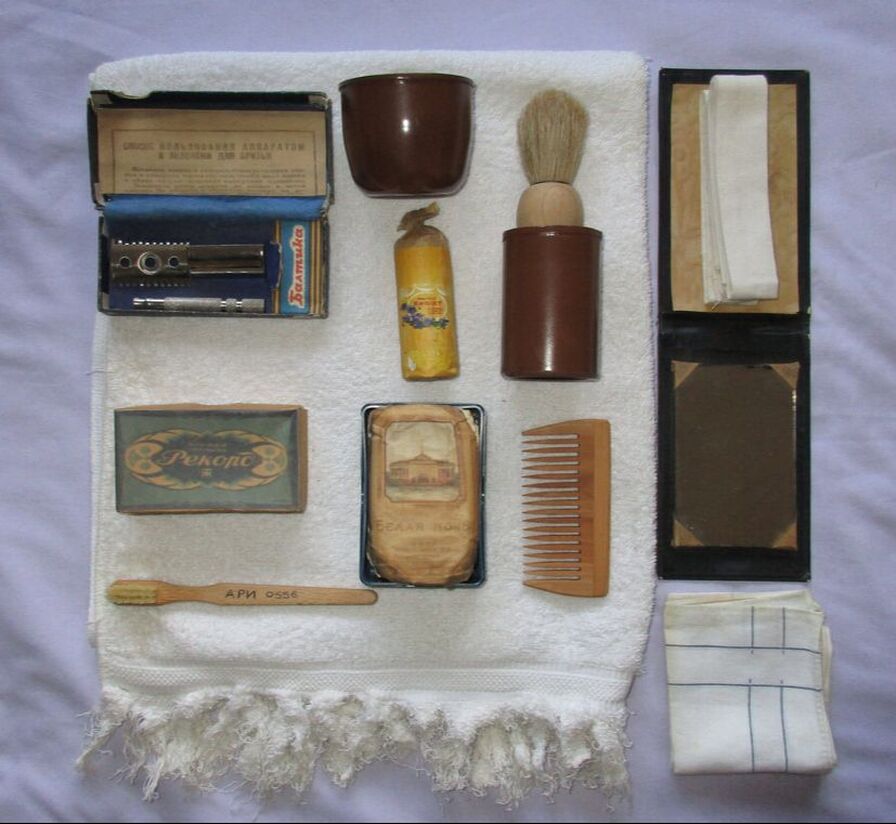
Clockwise from top left: Mid to late war impression: safety razor set, shaving brush and enamel cups, shaving soap stick,
spare collar liners, mirror in a cardboard cover, handkerchief, comb, soap and soap dish, tooth brush and tooth powder and a towel. The toiletry and shaving kit would have been stored in a small cloth drawstring bag or simply rolled within a towel.
spare collar liners, mirror in a cardboard cover, handkerchief, comb, soap and soap dish, tooth brush and tooth powder and a towel. The toiletry and shaving kit would have been stored in a small cloth drawstring bag or simply rolled within a towel.
Neezhnye byelye or underwear.
In summer a light cotton undershirt was worn with either cotton undershorts or 'long john' under trousers.
It was also common for soldiers to wear civilian clothing under the uniform, particularly during the winter.
The enlisted man received the following issue of underwear per annum:
Undershirts - summer x 2, winter warm x 1.
Undershorts - summer x 3, winter warm x 1.
Portyanki (Footcloth) - summer x 3, winter warm x 2. Rectangular in shape 90 cm x 37 cm.
The underwear was supposedly exchanged every ten days for a clean set. Invariably, the soldier often got someone else's
underwear back from the laundry!
In summer the portyanki footwraps were made of linen material and in winter made from warm cotton flannel and wool mix material.
It was also common for soldiers to wear civilian clothing under the uniform, particularly during the winter.
The enlisted man received the following issue of underwear per annum:
Undershirts - summer x 2, winter warm x 1.
Undershorts - summer x 3, winter warm x 1.
Portyanki (Footcloth) - summer x 3, winter warm x 2. Rectangular in shape 90 cm x 37 cm.
The underwear was supposedly exchanged every ten days for a clean set. Invariably, the soldier often got someone else's
underwear back from the laundry!
In summer the portyanki footwraps were made of linen material and in winter made from warm cotton flannel and wool mix material.
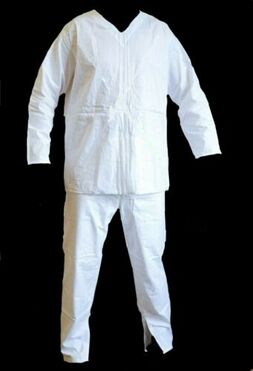
In winter a warm cotton flannel version of the undershirt was issued together with 'long john' under trousers, which translates in Russian as длинное нижнее белье
(dlinnoye nizhneye bel'ye)
Personal items.
Your impression will be enhanced with the inclusion of period personal items such as above.
Clockwise from top left: Trouser belt, small spoon, traditional soldiers red tobacco pouch (which often bore personalised embroidery),cigarette papers,box of matches (which often bore patriotic imagery), packet of "Makhorka" tobacco (lit. poor tobacco in Russian), hand rolled cigarettes (because of their shape were nicknamed koz'ya noga -goats leg and were often rolled using old newspaper), field made flint lighter, made from a German 7.92 mm cartridge case, playing cards, torch, "Belomorkanal" papierossi cigarettes, small pouch, which would hold paper twists of salt,pepper, sugar, sunflower seeds etc, bag containing domino's, soldiers RKKA ID booklet, pocket knife, Bakelite tube and paper roll with soldiers ID details, field postcards, personal letter and photos, wallet, State Bank currency notes and coins, notebook and pencil.
As well as domino's and playing cards, other popular past times with troops included, chess,chequers and playing of musical instruments, such as the traditional balalaika, violin and guitar, as was listening to musical programs on a wireless set and communal singing. Concerts were also held in rear echelon areas often consisting of choirs, orchestral music, dancing and circus type performances etc, generally all of a patriotic theme!
Clockwise from top left: Trouser belt, small spoon, traditional soldiers red tobacco pouch (which often bore personalised embroidery),cigarette papers,box of matches (which often bore patriotic imagery), packet of "Makhorka" tobacco (lit. poor tobacco in Russian), hand rolled cigarettes (because of their shape were nicknamed koz'ya noga -goats leg and were often rolled using old newspaper), field made flint lighter, made from a German 7.92 mm cartridge case, playing cards, torch, "Belomorkanal" papierossi cigarettes, small pouch, which would hold paper twists of salt,pepper, sugar, sunflower seeds etc, bag containing domino's, soldiers RKKA ID booklet, pocket knife, Bakelite tube and paper roll with soldiers ID details, field postcards, personal letter and photos, wallet, State Bank currency notes and coins, notebook and pencil.
As well as domino's and playing cards, other popular past times with troops included, chess,chequers and playing of musical instruments, such as the traditional balalaika, violin and guitar, as was listening to musical programs on a wireless set and communal singing. Concerts were also held in rear echelon areas often consisting of choirs, orchestral music, dancing and circus type performances etc, generally all of a patriotic theme!
THIS CONCLUDES THE GUIDANCE SECTIONS ON THE BASIC UNIFORM AND EQUIPMENT PAGES. ITEMS SUCH AS WINTER UNIFORMS AND CAMOUFLAGE CLOTHING, TOGETHER WITH OTHER ARTICLES OF INTEREST HAVE BEEN INCLUDED IN THE MISCELLANEOUS SECTION, UNDER THE "MORE" HEADER AT THE TOP OF THE PAGE.

